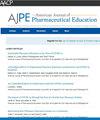Key Findings and Recommendations from the American Association of College of Pharmacy Curriculum Quality Survey of US Pharmacy School Faculty
IF 3.8
4区 教育学
Q1 EDUCATION, SCIENTIFIC DISCIPLINES
引用次数: 0
Abstract
Objective
To evaluate the faculty perspectives on how well pharmacy programs achieve key areas in the American Association of Colleges of Pharmacy faculty survey, including administration, governance, faculty development, infrastructure, curriculum, teaching, and student supervision.
Methods
American Association of Colleges of Pharmacy Curriculum Quality Survey data from 2016 to 2023 were analyzed. The survey included 40 Likert-scale questions (rated from 1 to 5: Strongly Agree to Strongly Disagree). Questions were grouped into the following categories: organizational structure, administration, faculty support, curriculum, and resources. Responses for “Agree’’ and “Strongly Agree’’ were combined to report the overall agreement levels. An Independent Samples t-test was used to compare the mean agreement levels between private and public institutions, and trend analysis was conducted for each item.
Results
Faculty agreements ranged from 49.8 ± 2.5% to 94.8 ± 0.7% in public and 56.2 ± 2.3% to 95.8 ± 0.7% in private institutions. Private institutions exhibited statistically significant higher agreement levels than public institutions in faculty development, while public institutions exhibited statistically significant higher agreement levels in resources, infrastructure, professionalism, and culture.
Conclusion
Faculty concerns include leadership, resource allocation, and professional development across public and private institutions. Recommendations include strengthening cultural competency training, leadership, governance, faculty recruitment, emerging technologies, and interprofessional education. Although based on the Accreditation Council for Pharmacy Education Standards 2016, these analyses remain relevant to Accreditation Council for Pharmacy Education Standards 2025, which incorporate the earlier standards in a reorganized format.
美国药学院协会对美国药学院教师课程质量调查的主要发现和建议。
目的:评估教师对美国药学院协会(AACP)教师调查中药学项目实现关键领域的看法,包括行政、治理、教师发展、基础设施、课程、教学和学生监督。方法:分析2016 - 2023年AACP课程质量调查(CQS)数据。该调查包括40个李克特量表问题(1-5:非常同意到非常不同意)。问题按主题分类:组织结构、管理、教师支持、课程和资源。“同意”和“非常同意”的回答结合起来报告总体同意程度。独立样本t检验比较了私营和公共机构之间的平均协议水平,并对每个项目进行趋势分析。结果:公立院校的教师满意率为49.8±2.5% ~ 94.8±0.7%,民办院校为56.2±2.3% ~ 95.8±0.7%。在师资发展方面,私立院校的一致性显著高于公立院校,而公立院校在资源、基础设施、专业精神和文化方面的一致性显著高于公立院校。结论:教师关注的问题包括领导能力、资源分配和公私院校的专业发展。建议包括加强文化能力培训、领导力、治理、教师招聘、新兴技术和跨专业教育。虽然基于2016年药学教育认证委员会(ACPE)标准,但这些分析仍然与2025年ACPE标准相关,该标准以重组的格式完全纳入了早期的标准。
本文章由计算机程序翻译,如有差异,请以英文原文为准。
求助全文
约1分钟内获得全文
求助全文
来源期刊
CiteScore
4.30
自引率
15.20%
发文量
114
期刊介绍:
The Journal accepts unsolicited manuscripts that have not been published and are not under consideration for publication elsewhere. The Journal only considers material related to pharmaceutical education for publication. Authors must prepare manuscripts to conform to the Journal style (Author Instructions). All manuscripts are subject to peer review and approval by the editor prior to acceptance for publication. Reviewers are assigned by the editor with the advice of the editorial board as needed. Manuscripts are submitted and processed online (Submit a Manuscript) using Editorial Manager, an online manuscript tracking system that facilitates communication between the editorial office, editor, associate editors, reviewers, and authors.
After a manuscript is accepted, it is scheduled for publication in an upcoming issue of the Journal. All manuscripts are formatted and copyedited, and returned to the author for review and approval of the changes. Approximately 2 weeks prior to publication, the author receives an electronic proof of the article for final review and approval. Authors are not assessed page charges for publication.

 求助内容:
求助内容: 应助结果提醒方式:
应助结果提醒方式:


